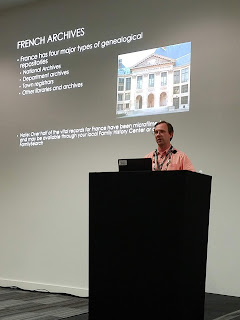 |
| Map of Ohio where my research is focused. |
First of all, I want to discuss the general process of finding the sources for your locations. This step, developing a locality guide, can help you learn more about the area you are researching and help you find the important resources that you need to be successful. The FamilyLocket blog and podcast have some great tips on creating locality guides. They have three podcasts on this specific topic: RLP 4, RLP 5, and RLP 18.
Where are some good places to begin developing your locality guide? First, I would suggest using the FamilySearch Wiki. If you aren't familiar with the FamilySearch Wiki, it is "a free, online genealogical guide created and maintained by FamilySearch. It contains links to genealogy databases, websites, other resources, research strategies, and genealogical guidance to assist in the search for your ancestors. Articles included are locality pages for countries around the world and topic pages that include pertinent genealogy record types explaining how to use the record, what it contains, and how to find it." The Wiki is developed and edited by teams of users, much like Wikipedia, who are familiar with the research topic and want to help provide the resources necessary for you to have successful discoveries. The Wiki can be searched by genealogy topic as well as locality. Since the topics are developed by volunteers, some sections may be more complete than others. For example, in my research of Auglaize, Darke, Mercer and Shelby counties in Ohio, I would look up each county in the Wiki to see what information is readily available: Auglaize, Darke, Mercer, Shelby.
Another website that I would use to help develop my locality guide is The Family History Guide. The Family History Guide is generally seen as a tutorial for learning how to use the big four genealogy sites (FamilySearch, Ancestry, FindMyPast, and MyHeritage) but it is also a great resource for finding locality information to help research your ancestors. To find the location information, click on Countries in the menu bar at the top of the Family History Guide web page and select the country you want to research. In my case I selected United States. Once on the US page, I selected Ohio from the list of states under the title bar and before the general lessons on US Records and Searches. On the Ohio page there are a series of general lessons to help you understand researching the state and there is a list of county resources at the bottom of the page. This list has the name of each county and a series of letters (for example, Auglaize A L G U). Clicking on the county name will take you to the FamilySearch Wiki page for that county. Clicking the A links you to the Ancestry card catalog for that location, L goes to the Linkpendium list for that location, G goes to Genealogy Inc's list for the location, and U goes to the USGenWeb page for the location. Each of these sites may provide you additional resources to add to your locality guide.
Google is another source for your research. Make sure you do a thorough search on Google and its various sites. Searching Google can help you find the local historical societies, libraries and museums which may have resources of information that can assist you. The search can also link you with others researching the same families and locations. Searching Google Books can provide county histories and other resources that can help build the historical context for your research. For example, I was able to find a book titled "History of Western Ohio and Auglaize County with Illustrations and Biographical Sketches of Pioneers and Prominent Public Men" published in 1905. These county histories can provide excellent hints for your research.
Newspapers are also an important resource when researching a particular location. I was lucky enough to have several of my local newspapers already online for free. One of my favorite free sites to look up newspapers is Ancestor Hunt. They have a general page about using newspapers for your research and a more specific page for finding resources by state. For Ohio, they have links to several hundred newspapers around the state in various collections. Two of my most used newspaper resources are the Community History Archive of the Coldwater Public Library and the Minster Historical Society's Newspaper Collection. These collections have more than 100 years worth of local newspapers for the Auglaize County area available online. You might also have luck finding local newspapers on the Library of Congress' Chronicling America site. Other locations to look for newspapers are University collections. For example, Bowling Green State University has their collection of newspapers here.
I also suggest that you look at maps for your area as you are researching. Historic maps will show boundary changes and potentially towns that no longer exist. Plat maps will show land ownership changes over time. Current maps will help provide current landmarks for you to use during your research. One of my favorite mapping sites is Historic Map Works. They provide a variety of old maps including plat maps and gazetteers. Sanborn Fire Insurance Maps can provide details about buildings in an area. These maps show the footprint, construction materials, and floor plans of various building. Examples of these maps can be found in the Library of Congress map collections.
I hope these links will help you develop your locality guide and set you on the way to successful researching. Merry Christmas, Happy Holidays and Happy New Year to all!


































